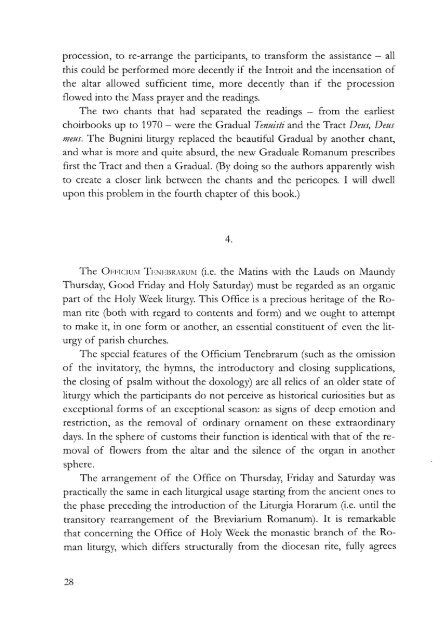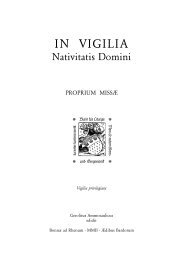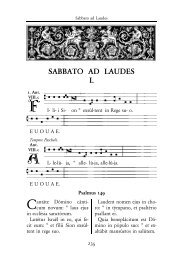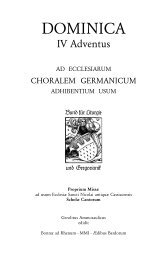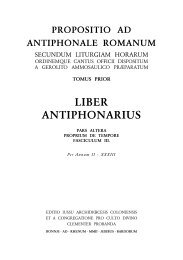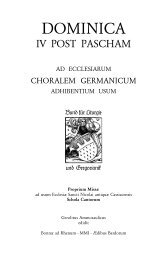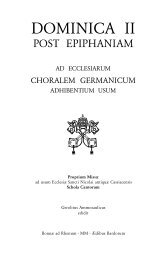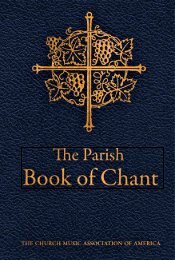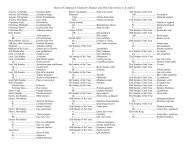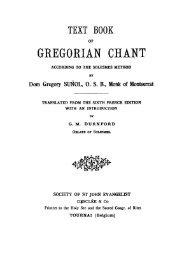The Bugnini-Liturgy and the Reform of the Reform - MusicaSacra
The Bugnini-Liturgy and the Reform of the Reform - MusicaSacra
The Bugnini-Liturgy and the Reform of the Reform - MusicaSacra
Create successful ePaper yourself
Turn your PDF publications into a flip-book with our unique Google optimized e-Paper software.
procession, to re-arrange <strong>the</strong> participants, to transform <strong>the</strong> assistance — all<br />
this could be performed more decently if <strong>the</strong> Introit <strong>and</strong> <strong>the</strong> incensation <strong>of</strong><br />
<strong>the</strong> altar allowed sufficient time, more decently than if <strong>the</strong> procession<br />
flowed into <strong>the</strong> Mass prayer <strong>and</strong> <strong>the</strong> readings.<br />
<strong>The</strong> two chants that had separated <strong>the</strong> readings - from <strong>the</strong> earliest<br />
choirbooks up to 1970 — were <strong>the</strong> Gradual Tenuisti <strong>and</strong> <strong>the</strong> Tract Deus, Deus<br />
meus. <strong>The</strong> <strong>Bugnini</strong> liturgy replaced <strong>the</strong> beautiful Gradual by ano<strong>the</strong>r chant,<br />
<strong>and</strong> what is more <strong>and</strong> quite absurd, <strong>the</strong> new Graduale Romanum prescribes<br />
first <strong>the</strong> Tract <strong>and</strong> <strong>the</strong>n a Gradual. (By doing so <strong>the</strong> authors apparently wish<br />
to create a closer link between <strong>the</strong> chants <strong>and</strong> <strong>the</strong> pericopes. I will dwell<br />
upon this problem in <strong>the</strong> fourth chapter <strong>of</strong> this book.)<br />
4.<br />
<strong>The</strong> Oi'i-iciuM TKNKBRARUM (i.e. <strong>the</strong> Matins with <strong>the</strong> Lauds on Maundy<br />
Thursday, Good Friday <strong>and</strong> Holy Saturday) must be regarded as an organic<br />
part <strong>of</strong> <strong>the</strong> Holy Week liturgy. This Office is a precious heritage <strong>of</strong> <strong>the</strong> Roman<br />
rite (both with regard to contents <strong>and</strong> form) <strong>and</strong> we ought to attempt<br />
to make it, in one form or ano<strong>the</strong>r, an essential constituent <strong>of</strong> even <strong>the</strong> liturgy<br />
<strong>of</strong> parish churches.<br />
<strong>The</strong> special features <strong>of</strong> <strong>the</strong> Offlcium Tenebrarum (such as <strong>the</strong> omission<br />
<strong>of</strong> <strong>the</strong> invitatory, <strong>the</strong> hymns, <strong>the</strong> introductory <strong>and</strong> closing supplications,<br />
<strong>the</strong> closing <strong>of</strong> psalm without <strong>the</strong> doxology) are all relics <strong>of</strong> an older state <strong>of</strong><br />
liturgy which <strong>the</strong> participants do not perceive as historical curiosities but as<br />
exceptional forms <strong>of</strong> an exceptional season: as signs <strong>of</strong> deep emotion <strong>and</strong><br />
restriction, as <strong>the</strong> removal <strong>of</strong> ordinary ornament on <strong>the</strong>se extraordinary<br />
days. In <strong>the</strong> sphere <strong>of</strong> customs <strong>the</strong>ir function is identical with that <strong>of</strong> <strong>the</strong> removal<br />
<strong>of</strong> flowers from <strong>the</strong> altar <strong>and</strong> <strong>the</strong> silence <strong>of</strong> <strong>the</strong> organ in ano<strong>the</strong>r<br />
sphere.<br />
<strong>The</strong> arrangement <strong>of</strong> <strong>the</strong> Office on Thursday, Friday <strong>and</strong> Saturday was<br />
practically <strong>the</strong> same in each liturgical usage starting from <strong>the</strong> ancient ones to<br />
<strong>the</strong> phase preceding <strong>the</strong> introduction <strong>of</strong> <strong>the</strong> Liturgia Horarum (i.e. until <strong>the</strong><br />
transitory rearrangement <strong>of</strong> <strong>the</strong> Breviarium Romanum). It is remarkable<br />
that concerning <strong>the</strong> Office <strong>of</strong> Holy Week <strong>the</strong> monastic branch <strong>of</strong> <strong>the</strong> Roman<br />
liturgy, which differs structurally from <strong>the</strong> diocesan rite, fully agrees<br />
28


